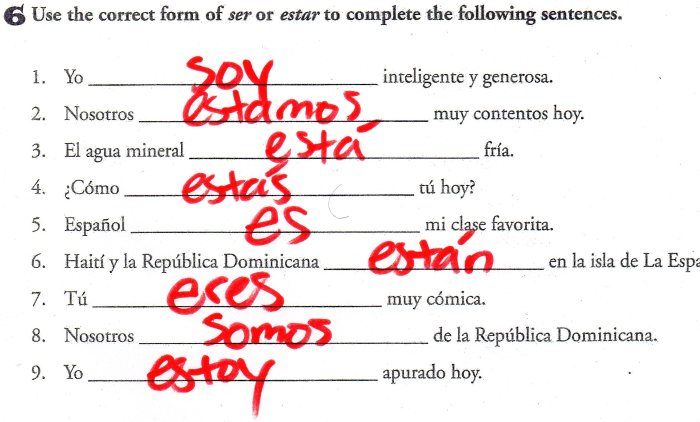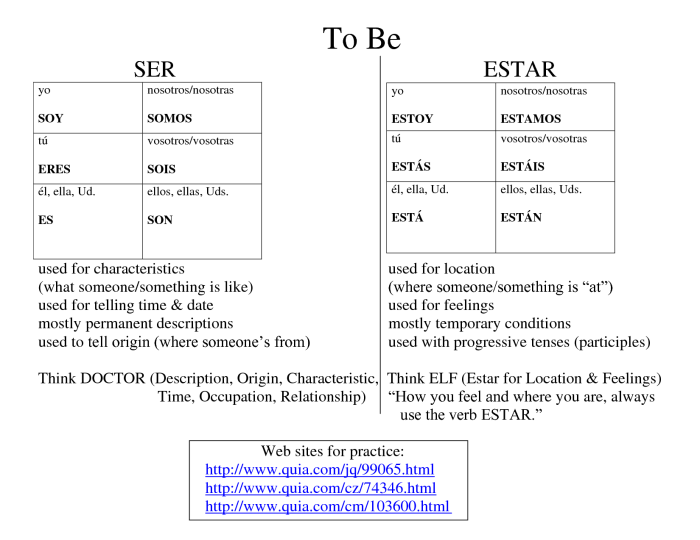Embark on an educational journey with our comprehensive El Verbo Estar Worksheet Answers, meticulously crafted to provide a profound understanding of this fundamental verb in Spanish. Delve into the intricacies of its conjugations, applications, and nuances, empowering you to express yourself with precision and confidence.
Our in-depth analysis of El Verbo Estar will illuminate its multifaceted usage, enabling you to navigate conversations, describe locations, convey emotions, and express temporary or permanent states with remarkable accuracy. Prepare to unlock the secrets of this versatile verb and elevate your Spanish language skills to new heights.
El Verbo Estar

El verbo “estar” en español es un verbo irregular que se utiliza para indicar ubicación, estados de ser y tiempo.
Conjugaciones en Presente
- yo estoy
- tú estás
- él/ella/usted está
- nosotros/nosotras estamos
- vosotros/vosotras estáis
- ellos/ellas/ustedes están
Tipos de Ubicaciones
El verbo “estar” se puede utilizar para expresar diferentes tipos de ubicaciones:
- Lugar físico: Estoy en la casa.
- Lugar abstracto: Estoy en un dilema.
- Posición o dirección: Estoy a la derecha.
Estados de Ser
Además de indicar ubicación, “estar” también se utiliza para expresar estados de ser:
- Emociones: Estoy feliz.
- Salud: Estoy enfermo.
- Condiciones temporales: Estoy cansado.
Diferencia entre “Estar” y “Ser”
El verbo “estar” se utiliza para estados temporales o cambiantes, mientras que “ser” se utiliza para características o cualidades inherentes.
Expresiones Temporales
El verbo “estar” se puede utilizar con expresiones temporales para indicar estados temporales o permanentes:
- Presente: Estoy aquí ahora.
- Pasado: Estuve en París el año pasado.
- Futuro: Estaré en la playa mañana.
Diferencia entre “Estar” y “Haber”
En expresiones temporales, “estar” se utiliza para estados actuales o futuros, mientras que “haber” se utiliza para estados pasados.
Uso de “Estar” en Contexto, El verbo estar worksheet answers
| Ubicación | Estado de Ser | Expresión Temporal | Ejemplo |
|---|---|---|---|
| En la escuela | Feliz | Ahora | Estoy feliz en la escuela. |
| Enfermo | Pasado | Ayer | Estuve enfermo ayer. |
| En la playa | Cansado | Futuro | Estaré cansado en la playa. |
| En un dilema | Triste | Presente | Estoy triste en un dilema. |
| A la derecha | Bien | Ahora | Estoy bien a la derecha. |
Questions and Answers: El Verbo Estar Worksheet Answers
What is the primary function of the verb “estar” in Spanish?
El Verbo Estar primarily serves to express location, states of being, and temporary conditions.
How do I conjugate “estar” in the present tense?
The present tense conjugations of “estar” are: estoy (I am), estás (you are), está (he/she/it is), estamos (we are), estáis (you are), and están (they are).
Can you provide an example of using “estar” to express a state of being?
Estoy feliz (I am happy).
How do I use “estar” with time expressions?
Estar can be used with time expressions to indicate temporary states. For example: Estoy aquí ahora (I am here now).
